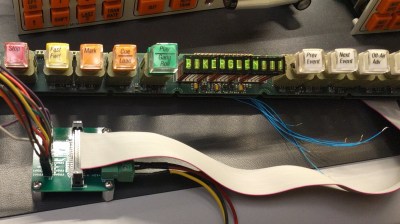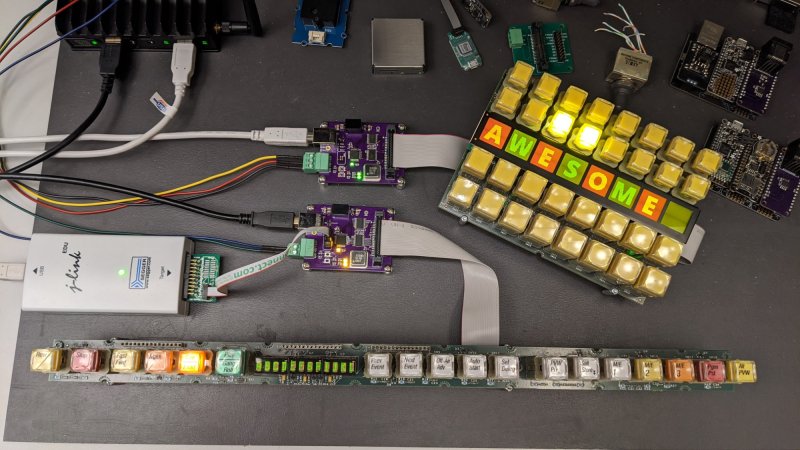Where does he get such wonderful toys? [Glenn] snagged parts of a Grass Valley Kalypso 4-M/E video mixer switcher control surface from eBay and since been reverse engineering the button and display modules to bend them to his will. The hardware dates back to the turn of the century and the two modules would have been laid out with up to a few dozen others to complete a video mixing switcher console.
[Glenn’s] previous adventures delved into a strip of ten backlit buttons and gives us a close look at each of the keyswitches and the technique he used to pull together his own pinout and schematic of that strip. But things get a lot hairier this time around. The long strip seen above is a “machine control plane” module and includes a dozen addressible character displays, driven by a combination of microcontrollers and FPGAs. The square panel is a “Crosspoint Switch Matrix” module include eight individual 32 x 32 LCDs drive by three dedicated ICs that can display in red, green, or amber.
 [Glen] used an STM8 Nucleo 64 to interface with the panels and wrote a bit of code to help map out what each pin on each machine control plane connector might do. He was able to stream out some packets from the plane that changed as he pressed buttons, and ended up feeding back a brute-force of that packet format to figure out the LED display protocols.
[Glen] used an STM8 Nucleo 64 to interface with the panels and wrote a bit of code to help map out what each pin on each machine control plane connector might do. He was able to stream out some packets from the plane that changed as he pressed buttons, and ended up feeding back a brute-force of that packet format to figure out the LED display protocols.
But the LCDs on the crosspoint switch were a more difficult nut to crack. He ended up going back to the original source of the equipment (eBay) to get a working control unit that he could sniff. He laid out a man-in-the-middle board that has a connector on either side with a pin header in the middle for his logic analyzer. As with most LCDs, the secret sauce was the initialization sequence — an almost impossible thing to brute force, yet exceedingly simple to sniff when you have a working system. So far he has them running under USB control, and if you are lucky enough to have some of this gear in your parts box, [Glen] has painstakingly recorded all of the details you need to get them up and running.















“The hardware dates back to the turn of the century…”
Geeze, thanks for making me feel like Methuselah’s older brother!
My own reaction:
“But they didn’t have electric video in the 1900’s, that can’t be… oh. oooh *sadface* “
“The hardware dates back to the turn of the century…”
I was wondering when we would start to write or say this.
So far, I have my doubts on the resurgence of “the roaring 20’s”.
Maybe as a biblical reference, “1 Peter 5:8 “Be sober, be vigilant; because your adversary the devil, as a roaring lion, walketh about, seeking whom he may devour.””
Old video equipment has great buttons and switches. Old Ampex VTRs, video switchers, Sony 1″ machines. Just really nice human interfaces back before the era of the mouse and touch screen.
That is true, but the modern stuff is much easier to carry :-D
I picked up a few grass valley panels when they were going to E-Waste a while ago, though I just desoldered the buttons and unsocketed the LED pixel displays. Still have them bagged up in the parts box somewhere… Figured it would be easier to layout a new PCB for any project than bend it to meet original layout.
You have to be careful with some grass valley panels actually as some only have a few of the display parts populated as they were built to order, so one on ebay with a massive window area (they are tinted) may not actually have loads of socketed displays behind them. Got caught out with that once.
What the heck is a ‘video mixer’? That thing was a video switcher and special effects generator (SEG).
In the UK and elsewhere, the switcher is a Vision Mixer, as is its operator (TD). While “video mixer” is not the usage in the US, functionally, that’s pretty much what it is and what it does. Have driven many a share of GVG panels before and after the “turn of the century.”
Yep, it’s definitely what I’d call a Mixer. From my experience in the broadcast industry the US has weird terminology all of its own, as well as weird requirements that the rest of the world doesn’t have.
A good point, I’ve made an update.
Wow, been over 15 years since I have seen a Kalypso board. I worked as a Process Engineer for the contract manufacturer making most of GVG’s video products. The wave solder fixtures for these boards were a work of art. They had a machined aluminum top plate with a conical cavity for each switch (the top of the switch without the keycap is round) that ensured that all switches were firmly seated and would be square to the final enclosure’s tight specs for the keycap opening.
Neat anecdote, thanks!
Holy cats! What a cool project and well documented!! At first I thought there might be a market in tearing down these big switchers for their panels and create digital switchers for streamers, but with the Stream Deck 15 LCD key unit only costing $160, probably not a market for that…
Still a super cool project though. Something about these older sea-of-button machines with cool displays always get me excited.
UMMM, how did I miss this? We still use a Kalypso system!